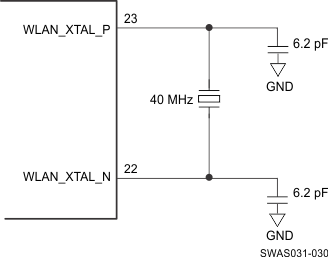SWAS037C February 2019 – December 2024 CC3135
PRODUCTION DATA
- 1
- 1 Features
- 2 Applications
- 3 Description
- 4 Functional Block Diagram
- 5 Device Comparison
- 6 Pin Configuration and Functions
-
7 Specifications
- 7.1 Absolute Maximum Ratings
- 7.2 ESD Ratings
- 7.3 Power-On Hours (POH)
- 7.4 Recommended Operating Conditions
- 7.5 Current Consumption Summary: 2.4 GHz RF Band
- 7.6 Current Consumption Summary: 5 GHz RF Band
- 7.7 TX Power Control for 2.4 GHz Band
- 7.8 TX Power Control for 5 GHz
- 7.9 Brownout and Blackout Conditions
- 7.10 Electrical Characteristics for DIO Pins
- 7.11 Electrical Characteristics for Pin Internal Pullup and Pulldown
- 7.12 WLAN Receiver Characteristics
- 7.13 WLAN Transmitter Characteristics
- 7.14 WLAN Transmitter Out-of-Band Emissions
- 7.15 BLE/2.4 GHz Radio Coexistence and WLAN Coexistence Requirements
- 7.16 Thermal Resistance Characteristics for RGK Package
- 7.17 Timing and Switching Characteristics
- 7.18 External Interfaces
- 8 Detailed Description
- 9 Applications, Implementation, and Layout
- 10Device and Documentation Support
- 11Revision History
- 12Mechanical, Packaging, and Orderable Information
Package Options
Mechanical Data (Package|Pins)
- RGK|64
Thermal pad, mechanical data (Package|Pins)
- RGK|64
Orderable Information
7.17.5.3 Fast Clock (Fref) Using an External Crystal
The CC3135 device also incorporates an internal crystal oscillator to support a crystal-based fast clock. The crystal is fed directly between WLAN_XTAL_P (pin 23) and WLAN_XTAL_N (pin 22) with suitable loading capacitors.
Figure 7-11 shows the crystal connections for the fast clock.

NOTE: The crystal capacitance
must be tuned to ensure that the PPM requirement is met. See CC31xx & CC32xx Frequency Tuning for
information on frequency tuning.
Figure 7-11 Fast Clock Crystal Connections
Table 7-16 lists the WLAN fast-clock crystal requirements.